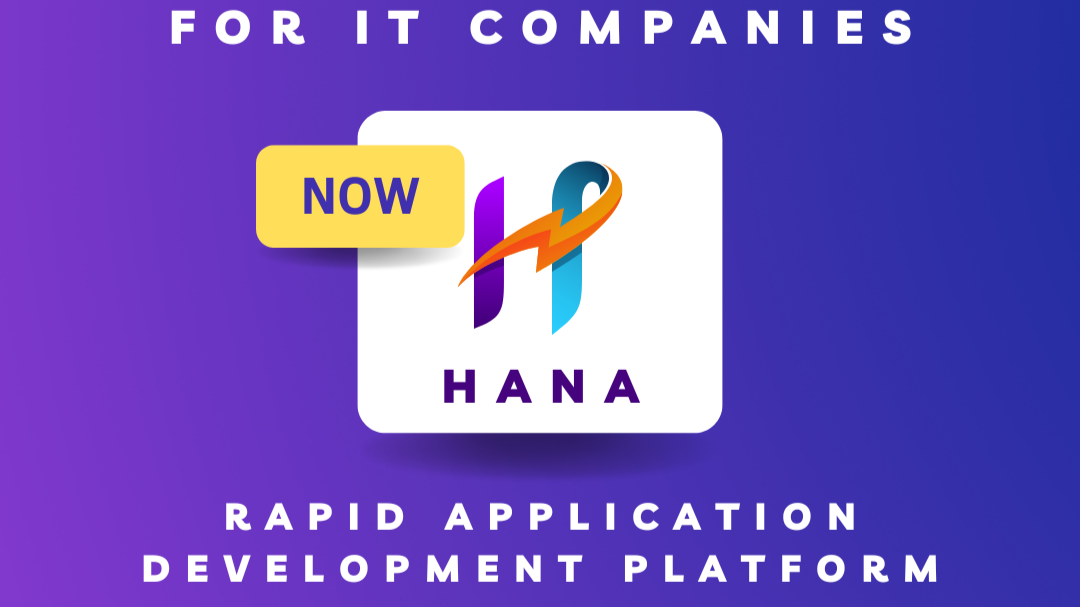- by admin
- April 24, 2025
For IT Companies

Even if Software Development Agencies have in-house developers, they can still benefit significantly from partnering with HANA, a Rapid Application Development (RAD) platform. Here’s how:
1. Faster Project Delivery
- Speed: HANA’s RAD tools allow agencies to build applications in a fraction of the time it would take with traditional development methods. Tasks that usually take weeks or months can be completed in days or even hours.
- Higher Client Turnaround: With faster delivery, agencies can take on more projects, increasing revenue potential without the need to expand their development team.
- Improved Client Satisfaction: Quick delivery times lead to happier clients, which can result in repeat business and referrals.
2. Reduced Development Costs
- Optimized Resource Utilization: Developers can focus on high-value tasks (like custom features, complex logic) while routine elements (such as UI components, forms, and reports) are built automatically using HANA.
- Lower Labor Costs: With HANA speeding up development, agencies can reduce billable hours per project, which translates to cost savings for the agency and the client.
- Pre-built Components: HANA offers reusable templates and libraries that cut down the need to code from scratch, further reducing development time and effort.
3. Flexibility and Customization
- Rapid Prototyping: Agencies can quickly build prototypes to showcase to clients. This allows for early feedback and course correction before significant development efforts are invested.
- Scalable Solutions: Even if the app starts as a simple project, HANA’s integration with the MERN stack ensures scalability, so agencies can easily extend the app as client needs grow.
- Tailored Features: While HANA automates many aspects, developers can still fully customize the applications, integrating unique client requirements without restrictions.
4. Focus on Core Competencies
- Efficiency: HANA handles the tedious aspects of app building, allowing in-house developers to focus on more complex and critical components like custom logic, APIs, or integrations with third-party services.
- Resource Flexibility: Agencies can reallocate their skilled developers to higher-value projects or innovation initiatives, rather than spending time on basic interface design and common app functions.
- Innovation: By using HANA, agencies can allocate more resources to research and development of new features, keeping them competitive.
5. Increased Profit Margins
- More Projects, Less Time: Completing projects faster allows agencies to take on more clients without expanding their team, improving revenue generation without proportional increases in operational costs.
- Efficient Client Customization: With HANA’s modular and template-based approach, agencies can offer client-specific customizations more efficiently, which may be priced as premium services.
- Subscription Revenue: If the agency opts for HANA’s SaaS model, they can pass on subscription costs to clients or bundle hosting services, generating an additional revenue stream.
6. Support for Cross-Platform Development
- Web, Mobile, and Admin Panels: HANA allows agencies to build applications for web, mobile, and admin panels simultaneously, streamlining development efforts across platforms.
- Consistent UX/UI: With predefined templates and a unified design approach, agencies can ensure a consistent user experience across all platforms, saving time on front-end design while maintaining high quality.
7. Smaller Teams Can Achieve More
- Leverage Smaller Teams: Even smaller development agencies can handle complex, large-scale projects thanks to the automation provided by HANA, allowing them to compete with larger agencies.
- Enhanced Team Collaboration: HANA’s unified environment for building, deploying, and managing applications fosters better collaboration among team members, simplifying workflows and project management.
8. Attract and Retain Clients
- Competitive Advantage: Agencies can offer clients faster delivery times, reduced costs, and more frequent updates, making them more competitive in the marketplace.
- Upsell Capabilities: Offering rapid development via HANA gives agencies the ability to upsell additional services such as faster prototyping, rapid iterations, and real-time feedback for ongoing projects.
9. Future-Proofing
- Adaptability to New Technologies: HANA’s underlying MERN stack ensures that applications are built on a modern and scalable tech stack, keeping the agency’s work relevant and future-proof.
- Continuous Improvements: As HANA evolves, agencies benefit from new features and updates that will help streamline their processes further.
10. White-Label Solutions
- Brand and Offer Your Own SaaS: Agencies can use HANA’s white-label capabilities to offer their own branded SaaS solutions to clients, opening up new business models and revenue streams without building a platform from scratch.
In summary, even with in-house developers, agencies can use HANA to speed up development, reduce costs, and focus on strategic work while maintaining the ability to deliver high-quality, customized solutions to their clients. This ultimately leads to better profitability, scalability, and higher client satisfaction.
